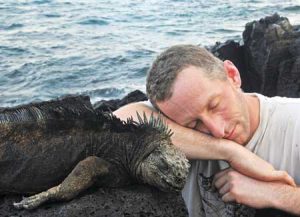
By Andrew Hendry
A few days ago I arrived in Galapagos for a short trip to touch base with our field crew working on the evolution of Darwin’s finches and the effects they have on plant communities. The work was proceeding apace and the birds were everywhere. The mind wanders …
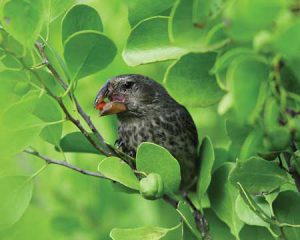
One of the things that Darwin found so striking about the Galapagos was the tameness of the fauna. He told many stories about how the animals simply had no fear of humans. A small boy sat beside some water and hit finches with a stick until he had his dinner. Darwin caught a marine iguana, threw it into the ocean, and it swam right back to him to be thrown in again – and again – and again. Darwin attributed all this innocence to the lack of prior experience of Galapagos fauna with humans – as opposed to mainland fauna that won’t let humans anywhere near.
In his 1939 book, now known as The Voyage of the Beagle, Darwin wasn’t very explicit about why this difference might have arisen – that is, he didn’t provide a formal evolutionary explanation. But evolution is, clearly, the reason. Animals that live with humans evolve to be afraid of them because genes for being afraid confer life and are thereby passed on to the next generation. Of course, individual animals can also learn from experience to avoid humans but this learning ability is still often an evolutionary response to human depredation.
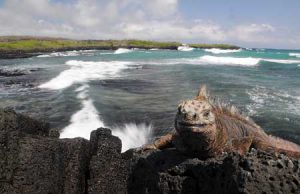
Galapagos fauna are still very tame despite now having had several more centuries of experience with humans. You can still walk within several feet of a finch or iguana or tortoise, although hitting them with sticks or throwing them in the water is obviously no longer a common activity.
So it seems that Galapagos fauna have not evolved to avoid humans despite now having been persecuted on the Galapagos for centuries. Or have they? Perhaps they have evolved and our collective perceptions are simply not up to the task.
Normal is a moving target
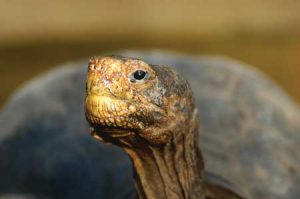
Consider the idea of the “shifting baseline,” where we think the state of the recent past is what is normal – when it might be anything but. For instance, we might think that we should recover our fish stocks to levels seen in the 1950s (or whenever) because we think those were the “right” levels based on our past experience. In reality, however, the abundance of fish might have been much higher even earlier. In essence, our baseline for what is “normal” gets reset each generation by our own past experiences rather than those of our forebearers.
In the case of Galapagos, maybe the fauna really are getting less tame through time but they remain so much more tame than the baseline of our experience – the mainland fauna that we live around – that we don’t imagine much change has occurred. I suppose we could call this the problem of the “distant baseline.”
So how can we escape from dulling our sensitivity to change because we are constantly referring to the distant baseline? One possibility might be to compare Galapagos fauna at places that have more or less human activity.
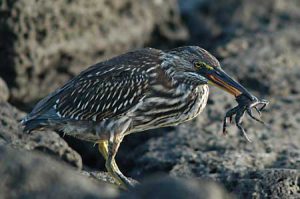
During my first few years in Galapagos, I tried very hard to get pictures of Sally Lightfoot crabs, those beautiful red crabs that dot the lava along the ocean, picking away at the algae on the rocks. But at the site I was staying, beside the town of Puerto Ayora, this was really hard. Whenever I got close, the crabs would leap away to a new rock or scuttle into a crevasse.
A few years later, I started doing work at Borrero Bay, a site on the north side of the island away from any human influence. All of a sudden these crabs were everywhere and I could just walk right up to them. I soon had hundreds of photos with crabs filling the frame.
This difference in crab behavior between a site with lots of humans (Puerto Ayora) and a site without humans (Borrero Bay) got me thinking that perhaps crabs at the former site have indeed evolved into scaredy cats. Perhaps dogs chase and kill them at Puerto Ayora and I am told that humans use them for bait – or at least they used to.
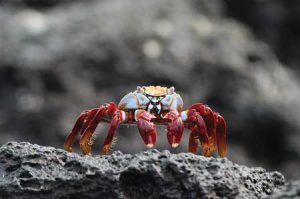
How has this difference in tameness between the two sites arisen? Has there been genetic divergence (evolution!) in behavior between crabs on the two sides of the island? This would be surprising because these crab larvae are released into the open water and so we might expect a single mixed population across the island – leaving no room for genetic divergence. In this case, perhaps we are instead seeing the activation of learning behavior that had evolved elsewhere in these crabs and then been retained following their colonization of Galapagos? Anyway, this was the state of my thinking until yesterday.
Evolution of learning
Yesterday I took a walk on beach by Puerto Ayora and the crabs were still very shy. But this time, I noticed several small lava herons stalking them and dashing out in an effort to catch them – although I didn’t see any successes.
Could it be that herons are more common here than at Borrero and have driven the divergence in behavior? Or could it be that herons have caused the evolution of learning to avoid two-legged things on the beach in the Galapagos, and this behavior is simply turned on more often at Puerto Ayora owing to the commonness of humans?
Exploring further, I found that crabs were, in fact, very tame at a small site on the grounds of the Charles Darwin Research Station beside Puerto Ayora (although they were not as tame as at Borrero).
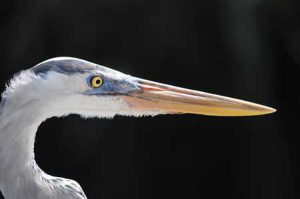
Access to this site is restricted and so crab persecution is presumably very low – although the herons are still present. So maybe this supports the direct role of humans because tameness here has re-emerged when humans no longer hunt crabs. And it also suggests that the effect must be due to learning (evolved though it might be) rather than genetic differences between sites – because the differences here were on a very small scale.
It would fun to someday quantify these behaviors and their spatial variation to see if these observations hold up under the real scientific scrutiny. Of course the other way to test these hypotheses even more rigorously would be to bring Darwin back to the Galapagos so he could compare the crabs of his day to those now. If only.
Text adapted from the blog: http://ecoevoevoeco.blogspot.ca/
Andrew Hendry is a professor in the Department of Biology.
